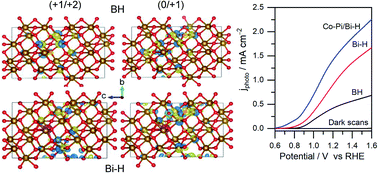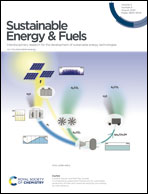Boosting the efficiency of water oxidation via surface states on hematite photoanodes by incorporating Bi3+ ions†
Abstract
The low mobility of charge carriers, high rate of electron/hole recombination, and sluggish water oxidation kinetics are the foremost drawbacks that limit the photoelectrochemical activity of hematite. Herein, a facile hydrothermal deposition method was used to incorporate Bi3+ ions into the crystal lattice of hematite to diminish the detrimental effects of those hitches. DFT simulations revealed that the Bi3+-ion incorporation into the crystal lattice of hematite is thermodynamically favorable despite it has a large ionic radius. This induces the creation of energetically shallow defect states in the bulk and thus enhances the donor density and the mobility of charge carriers. It further stabilizes the surface-defect states making them available for water oxidation. The enhancement of the donor density and the creation of surface-defect states (oxygen vacancies) were experimentally proven by electrochemical impedance and X-ray photoelectron spectroscopy measurements, respectively. Upon the modification with Co–Pi co-catalyst, the photocurrent density of Bi-incorporated hematite photoanodes reached an average value of 1.54 mA cm−2 at 1.23 V vs. RHE measured under standard solar irradiation. This value is 3.3- and 2-fold higher than those of bare and Co–Pi modified hematite photoanodes, respectively. The formed surface–defect states reduced the surface recombination and boosted the water oxidation kinetics as supported by the photoelectrochemical impedance spectroscopy, photovoltage, and transient photocurrent measurements. These results open a new avenue toward the investigation of post-transition metal elements to improve the efficiency of hematite photoanodes.



 Please wait while we load your content...
Please wait while we load your content...